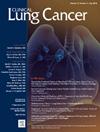Smoking and the Risk of Second Primary Lung Cancer Among Breast Cancer Survivors from the Population-Based UK Biobank Study
IF 3.3
3区 医学
Q2 ONCOLOGY
引用次数: 0
Abstract
Objective
Long-term breast cancer (BC) survivors are known to develop second malignancies, with second primary lung cancer (SPLC) one common type. Smoking was identified as a main risk factor for SPLC among BC survivors. These findings were limited to the U.S. and focused on smoking status, not incorporating cumulative smoking exposures (eg, pack-years). We examine SPLC incidence and evaluate the associations between SPLC risk and cumulative cigarette smoking exposures and other potential factors among BC survivors in a prospective European cohort.
Methods
Of 502,505 participants enrolled in the UK Biobank in 2006 to 2010, we identified 8429 patients diagnosed with BC between 2006 and 2016 and followed for second malignancies through 2016. Smoking information was collected at enrollment, and treatment data were collected using electronic health records. Multivariable cause-specific Cox regression (CSC) evaluated the association between each factor and SPLC risk.
Results
Of 8429 BC patients, 40 (0.47%) developed SPLC over 45,376 person-years. The 10-year cumulative SPLC incidence was 0.48% (95% CI = 0.33%-0.62%). The CSC analysis confirmed the association between SPLC and ever-smoking status (adjusted hazard-ratio (aHR) = 3.46 (P < .001). The analysis showed a 24% increment in SPLC risk per 10 smoking pack-years among BC survivors (aHR = 1.24 per-10 pack-years, P = .01). The associations between SPLC and other variables remained statistically insignificant. We applied the USPSTF lung cancer screening eligibility criteria and found that 80% of the 40 BC survivors who developed SPLC would have been ineligible for lung cancer screening.
Conclusion
In a large, European cohort, cumulative smoking exposure is significantly associated with SPLC risk among BC survivors.
基于人群的英国生物库研究中乳腺癌幸存者的吸烟与第二原发性肺癌风险。
目的:众所周知,长期乳腺癌(BC)幸存者会罹患第二种恶性肿瘤,其中第二原发性肺癌(SPLC)是一种常见类型。吸烟被认为是乳腺癌幸存者罹患第二原发性肺癌的主要风险因素。这些研究结果仅限于美国,而且只关注吸烟状况,没有纳入累积吸烟暴露(如包年)。我们在一个前瞻性欧洲队列中研究了SPLC的发病率,并评估了BC幸存者中SPLC风险与累积吸烟暴露及其他潜在因素之间的关联:在2006年至2010年期间加入英国生物库的502,505名参与者中,我们确定了8429名在2006年至2016年期间被诊断为BC的患者,并对他们的第二次恶性肿瘤随访至2016年。入库时收集了吸烟信息,并通过电子健康记录收集了治疗数据。多变量特异性病因考克斯回归(CSC)评估了各因素与SPLC风险之间的关联:在 8429 名 BC 患者中,有 40 人(0.47%)在 45376 人年中患了 SPLC。10年累计SPLC发病率为0.48%(95% CI = 0.33%-0.62%)。CSC分析证实了SPLC与曾经吸烟状态之间的关系(调整后危险比值(aHR)= 3.46(P < .001))。分析表明,在 BC 存活者中,每吸烟 10 包年,SPLC 风险增加 24%(aHR = 1.24 per-10 pack-years,P = .01)。SPLC 与其他变量之间的关系在统计学上仍不显著。我们采用了 USPSTF 肺癌筛查资格标准,发现在 40 名患 SPLC 的 BC 幸存者中,有 80% 不符合肺癌筛查资格:结论:在一个大型欧洲队列中,累积吸烟暴露与 BC 幸存者的 SPLC 风险显著相关。
本文章由计算机程序翻译,如有差异,请以英文原文为准。
求助全文
约1分钟内获得全文
求助全文
来源期刊

Clinical lung cancer
医学-肿瘤学
CiteScore
7.00
自引率
2.80%
发文量
159
审稿时长
24 days
期刊介绍:
Clinical Lung Cancer is a peer-reviewed bimonthly journal that publishes original articles describing various aspects of clinical and translational research of lung cancer. Clinical Lung Cancer is devoted to articles on detection, diagnosis, prevention, and treatment of lung cancer. The main emphasis is on recent scientific developments in all areas related to lung cancer. Specific areas of interest include clinical research and mechanistic approaches; drug sensitivity and resistance; gene and antisense therapy; pathology, markers, and prognostic indicators; chemoprevention strategies; multimodality therapy; and integration of various approaches.
 求助内容:
求助内容: 应助结果提醒方式:
应助结果提醒方式:


